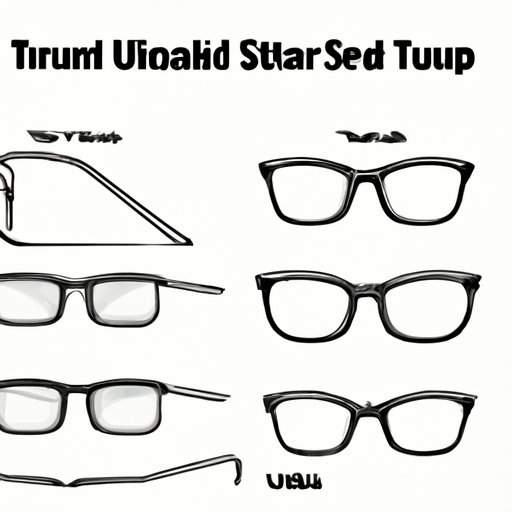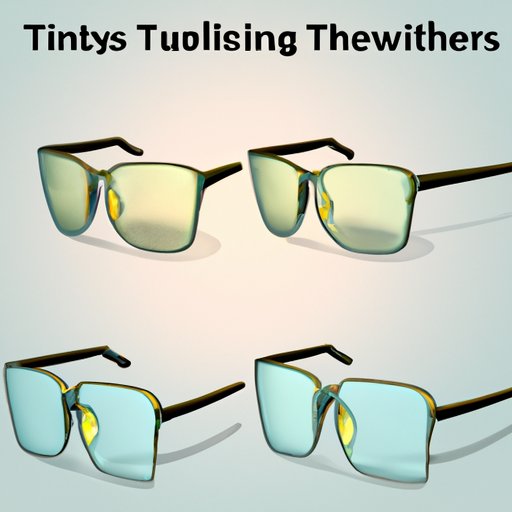
I. Introduction
Many artists, whether beginners or professionals, struggle with drawing glasses correctly. It can be challenging to get the shapes, proportions, and details just right, and many people end up making common mistakes. This article aims to provide a step-by-step guide with top tips, tutorials, and exercises to help readers draw glasses realistically and avoid those mistakes.
II. Step-by-Step Guide to Drawing Glasses
Before getting started, it’s essential to understand the basic shapes and proportions of glasses. They usually consist of a frame that sits on the ears and nose and two lenses that vary in size and shape. Here’s how to draw each part:
- Frames: Begin with a basic shape that fits the head, such as a rectangle, oval, or circle. Then, add the arms or temple pieces that sit on the ears. To make the frames look three-dimensional, add thickness and curved edges.
- Lenses: Draw two circles or ovals that fit the frames’ shape and size. Pay attention to the gap between the lenses and the frame. If the glasses have a nose pad, add a small triangle between the lenses.
- Nose Pad and Bridge: Draw the nose pad as a small triangle at the bridge of the glasses. The bridge should connect the two lenses and can vary in thickness and shape.
Use these instructions as a guide and adjust the shapes and proportions according to the glasses’ style and size. For more detailed instructions, check out the tutorials in the next section.
III. Top Tips for Drawing Realistic Glasses
To make glasses look realistic, pay attention to the following details:
- Shape and Framing: Depending on the style of glasses, they can sit differently on the face and have different proportions. Pay attention to the curvature of the lenses and the frame’s thickness and shape.
- Reflections: Glasses reflect light and objects around them, making them look shiny and transparent. Use white highlights and shading techniques to create reflections on the lenses and frames.
- Shading: Use different shading techniques to create depth and texture on the glasses’ surfaces. Hatching, cross-hatching, stippling, and blending are all useful methods for shading different parts of glasses.
For more details on these top tips, check out the following tutorial.

IV. Tutorial on Adding Shading and Texture to Glasses
Adding shading and texture to glasses can make them look more realistic and three-dimensional. Here are some tips and techniques:
- Shading Techniques: Experiment with different shading techniques such as hatching, cross-hatching, and stippling, depending on the effect you want to achieve. Use a lighter touch for the thinner parts and a heavier touch for the thicker parts.
- Texture: Use shading to create texture on the glasses’ frames and lenses. For example, create a metal texture by using cross-hatching and stippling, or add reflections and highlights to the lenses to create transparency and shine.
- Depth: Use highlights and shadows to create depth and make the glasses look three-dimensional. Pay attention to the light source and add shading and details accordingly.
With these techniques, you can add shading and texture to any type of glasses. For more detailed instructions and examples, check out the tutorials and exercises in the next section.
V. How to Draw Different Styles of Glasses
Glasses come in many different styles, from classic wireframes to bold statement glasses. Here are some tips and clear instructions on how to draw the most popular styles:
- Classic Wireframes: Start with thin, curved rectangles for the frames. Add thin arms that curve towards the ear and a small nose pad at the bridge. The lenses can be small and circular or oval-shaped.
- Bold Statement Glasses: These glasses can have thick frames in different shapes, such as rectangles, squares, or hearts. The lenses can be either clear or tinted, and the arms can be decorated with patterns or shapes.
- Half-Rimmed and Rimless Glasses: These glasses have frames that only cover the upper or lower part of the lenses, or no frames at all, leaving the lenses exposed on the sides and bottom. The shapes and designs can vary widely.
- Cat-Eye Glasses: These glasses have a distinctive, upswept shape that resembles a cat’s eye. The frames can be thick or thin and typically have a winged shape at the top corners. The lenses can be small or large and usually have a tinted gradient.
Use these instructions as a guide and adjust the shapes and proportions according to the glasses’ style and size. For more detailed instructions and examples, check out the tutorials and exercises in the next section.
VI. Drawing Glasses in Different Mediums
Glasses can be drawn in different mediums, such as pencils, pens, or digital tools. Here are some pros and cons for each:
- Pencils: Pencils are a classic drawing medium that allow for precise lines and shading. They are easy to use and erase.
- Pens: Pens can create crisp, detailed lines and add depth and texture to the drawings. However, they are less forgiving than pencils and cannot be erased easily.
- Digital Tools: Digital tools, such as tablets and software, offer a wide range of possibilities for drawing and editing. They allow for precise lines, easy color changes, and the ability to undo or redo the drawing.
Choose the medium that suits your style and skills the best, and practice until you feel comfortable with it. For more detailed instructions and examples, check out the tutorials and exercises in the next section.
VII. Common Mistakes and How to Avoid Them When Drawing Glasses
Some common mistakes when drawing glasses include:
- Proportions and Shape: Glasses can look too big, too small, or too slanted if the proportions and shape are not correct. Pay attention to the curves, angles, and distances between the different parts of the glasses.
- Reflections and Shading: Glasses can look flat and unrealistic if the reflections and shading are not done correctly. Pay attention to the light source and create highlights and shadows accordingly.
- Nose Pad and Bridge: The nose pad and bridge can be challenging to draw, as they are small details that can affect the glasses’ overall look. Pay attention to their size and position, and adjust them accordingly.
To avoid these mistakes, use the step-by-step guide, top tips, and tutorials, and practice consistently until you feel confident in your skills.
VIII. Drawing Glasses on Different Face Shapes and Angles
Drawing glasses on different face shapes and angles can be challenging, but practice and paying attention to the details can help. Here are some practical examples and exercises:
- Oval Face: Draw glasses that are wider than the face and have a gentle curve. Avoid glasses that are too narrow or too small.
- Square Face: Draw glasses that have rounded edges and are slightly wider than the face. Avoid glasses that are too angular or too narrow.
- Heart-Shaped Face: Draw glasses that are wider at the top and have a gentle curve. Avoid glasses that are too narrow or too round.
- Round Face: Draw glasses that have straight edges and angular shapes. Avoid glasses that are too round or too narrow.
For more detailed instructions and exercises on drawing glasses on different face shapes and angles, check out the tutorials in the previous sections.
IX. Conclusion
In conclusion, drawing glasses can be challenging, but with a step-by-step guide, top tips, tutorials, and exercises, anyone can learn how to draw them realistically. By paying attention to the details, the shape, and the proportions, and practicing consistently, you can improve your skills and create stunning drawings of glasses on different face shapes and angles.




